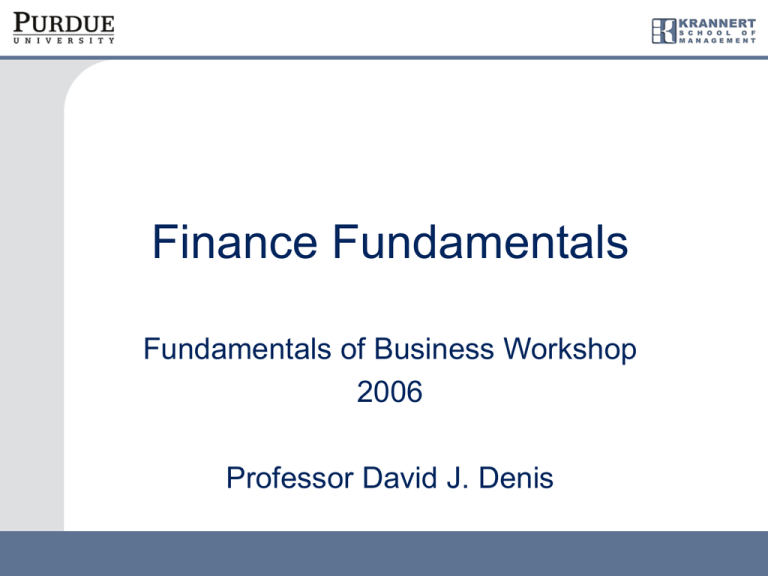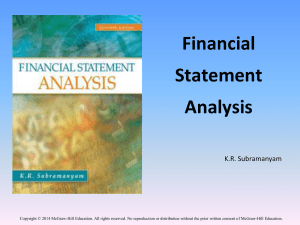Finance Fundamentals Fundamentals of Business Workshop 2006 Professor David J. Denis
advertisement

Finance Fundamentals Fundamentals of Business Workshop 2006 Professor David J. Denis What is Finance? Branch of economics Economics – allocation of scarce resources Finance – resource = capital Two fundamental questions in financial management 1. 2. On what projects should funds be spent? (investment decisions) From where should the funds be obtained? (financing decisions) Topics to be Covered A. Financial planning – – Projection of future cash flows Need for capital B. Valuation 1. – – How much is company worth? How much equity must be given up to raise required capital? C. Sources of funding for entrepreneurs 2. – Where do we get the required capital? – On what terms? Topic I. Financial Planning Example: “How to go broke…while making a profit” What happened? – Increased sales lead to increases in receivables and greater expenditures on inventory. Because inventory is paid for right away and must be purchased in advance of sales, there is a net drain on cash. – How can this be avoided? Construct a financial plan that integrates production plans (inventory), marketing plans (e.g. sales and credit terms), financing plans. Components of financial plan Pro-forma financial statements Income statement Balance Sheet Outcomes Capital needs Future cash flows Generic Income Statement Sales - Cost of Goods Sold - Selling and Administrative Expenses - Depreciation - Interest -Research and Development Expenses = Earnings before tax (EBT) - Taxes = Net Income (NI) Generic Balance Sheet Assets Cash Accounts Receivable Inventory Property, Plant, Equipment Total Assets Liabilities and Owner’s Equity Accounts payable Wages payable Short-term debt Long-term debt Common stock Retained earnings Total Liabilities and Owners Equity Pro-forma financial statements Always begin with sales forecast Project expenses – often a % of sales Forecast changes in asset and liability accounts Topic II. Valuation Question: How much of the company’s equity will the entrepreneur have to give up in order to raise required amount of capital? – Depends on the value of the stream of uncertain future cash flows – need a technique for valuation Three primary techniques Discounted cash flow (DCF) Market multiples Venture capital method Discounted cash flow Time value of money What is the present value of $100 to be received next year? PV = CFt/(1+r)t If r = 10%, PV = 100/(1+0.1) = $90.91 What is r? Required rate of return – usually 40-60% in VC situations Market Multiples Apply valuation ratio of comparable firm to firm being valued. Examples: P-E, market value/book value, Market value/ Sales Problems: o What is the appropriate multiplier? o Start-ups frequently do not have positive earnings, may not yet be generating sales, and have few assets. Venture Capital Method Effectively combines the previous two methods. Commonly used in the private equity industry. – Project value at some point in the future using some sort of multiple – Discount that value to the present – Discount rate is more ad hoc – but usually high (40-75%). Topic III. Sources of Capital 1. 2. Debt Equity – – • Angels Venture Capitalists Strategic partners Two Fundamental Problems 1. 2. Information asymmetry Entrepreneur has better information than investor Moral hazard Entrepreneur has incentive to mislead investors Solutions Monitor/reduce asymmetry – – Angels typically know the entrepreneur VCs demand oversight role Discount the value of the company Contractual terms of financing agreement Terms of Financing Agreement Convertibles Staged financing Put features Right of first refusal






